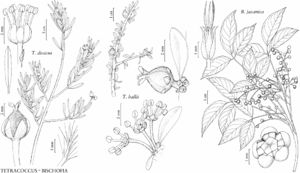Shrubs [perennial herbs or trees], evergreen, monoecious or dioecious. Leaves alternate, opposite, or whorled, simple [palmately compound]; stipules absent [present]; petiole present [absent]; blade margins entire, dentate, or serrate; venation pinnate. Inflorescences unisexual [bisexual], axillary, thyrses, fascicles [cymes], or flowers solitary. Flowers unisexual; perianth hypogynous; hypanthium absent; sepals [3–]4–13, distinct; petals 0; nectary present [absent]; stamens [2–]4–10[–55], distinct [rarely connate], free; anthers dehiscing by longitudinal slits; pistil 1, (2–)3–4(–5)-carpellate, ovary superior, (2–)3–4(–5)-locular; placentation axile; ovules [1–]2 per locule, anatropous; styles (2–)3–4(–5)[–8], distinct, unbranched [rarely 2-fid]; stigmas (2–)3–4(–5)[–8]. Fruits capsules [drupes], schizocarpic with cocci separating from persistent columella, coccus dehiscence septicidal [loculicidal]. Seeds 1–2 per locule.
Distribution
sw United States, Mexico, West Indies, Central America, South America, Asia, Africa, Pacific Islands, Australia, tropical and warm temperate regions.
Discussion
Genera 24, species ca. 90 (1 genus, 3 species in the flora).
The genera that make up Picrodendraceae traditionally have been treated as Euphorbiaceae subfam. Oldfieldioideae Eg. Köhler & G. L. Webster. This group has long been recognized as monophyletic because of its distinctive spiny pollen (G. A. Levin and M. G. Simpson 1994). Molecular data (Angiosperm Phylogeny Group 2003; K. Wurdack et al. 2004; C. C. Davis et al. 2005; Wurdack and Davis 2009) strongly support its monophyly and show that it is sister to Phyllanthaceae (formerly treated as Euphorbiaceae subfam. Phyllanthoideae) and more distant from Euphorbiaceae in the narrow sense.
Selected References
None.
